
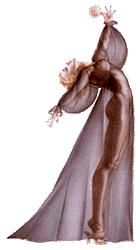
|
Cheesecakeand The Art of the Pin-upClassic Cheesecakepin-up n. |
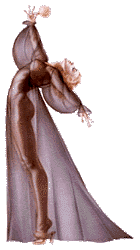
|
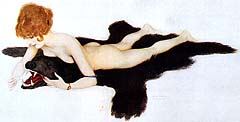
|
The subject -- a naked woman stretched out on a bearskin rug -- is classic pin-up, suggestive and sensual on a number of levels. The contrast of the soft fur and the model's naked skin offers the artist subtle textures to display his artistic talent and evokes a very sensual image to the viewer who can readily imagine the tactile sensation. The bear itself is a powerful, dangerous and masculine symbol, but here is safe and subdued. Still he bares his long sharp teeth, a reminder of his erstwhile danger and power. Finally, there is a bit of implied humor as the picture suggest the pun on the words bearskin and bare skin, both of which are well displayed.
The execution of this particular instance of the bearskin pin-up is also classic in the coyness and innocence of the model. She is naked but lying face down on the fur so that her breasts and front are covered. Her smile is quiet and she seems to be tempting the bear with a bit of food. All-in-all, the humor, sensuality, sexuality, innocence and feminine beauty of this picture add up to classic modern cheesecake pin-up.
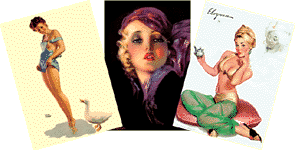
| ||||
| Zoë Mozert | ||||
| Earl Moran | Gil Elvgren | |||
The hay day of the pin-up was 30's through the 50's. These were the days of artists like George Petty, Alberto Vargas, Zoë Mozert, Earl Moran and Gil Elvgren.
 |
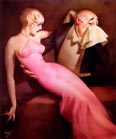 The first issue of Esquire magazine was published in 1933 and contained
a cartoon by an artist who would appear regularly in the magazine for a
decade: George Petty. Initially his work consisted
of painted cartoons of the elderly gentleman that was Esquire's mascot
with beautiful women sitting in his lap or escorting him. He was drawn
in a very cartoonish manner, but finished in a glossier than life style.
She was not as obviously cartoon-like, nor as glossily finished, but was
definitely in a sharper style than many of her contemporaries either in
pin-up art or on magazine covers. As time passed the squire vanished as
did the ladies' clothes, and the glossy airbrush style became more
pronounced.
The first issue of Esquire magazine was published in 1933 and contained
a cartoon by an artist who would appear regularly in the magazine for a
decade: George Petty. Initially his work consisted
of painted cartoons of the elderly gentleman that was Esquire's mascot
with beautiful women sitting in his lap or escorting him. He was drawn
in a very cartoonish manner, but finished in a glossier than life style.
She was not as obviously cartoon-like, nor as glossily finished, but was
definitely in a sharper style than many of her contemporaries either in
pin-up art or on magazine covers. As time passed the squire vanished as
did the ladies' clothes, and the glossy airbrush style became more
pronounced.

|
Unfortunately, important as the Petty Girl had been to Esquire's success from the very start, Petty was never very well paid for them. By the 1940's Petty's career was booming and money became a major issue between him and the magazine, and in 1942 Esquire published their last Petty girl.
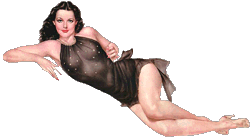
|
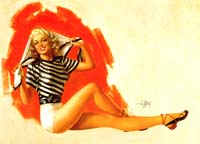
|
Mozert was born Alice Adelaide Moser, but adopted the name Zoë Mozert because she didn't think her own name sounded like someone famous and because with the Z's and the final T it made such an attractive signature to sign her paintings with. Her training was as an illustrator of the classic Howard Pyle school. She started her career in New York City in 1932 painting movie posters and the covers of movie magazines, and produced more than two covers a week over the next four years. In the 1940's, Mozert signed a contract with Bigelow and Brown and doing calendars and nudes.
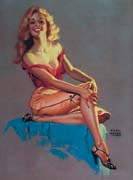
|
Shortly after the second World War, Moran's wife accused him of adultery with one of his models and divorced him. He moved to Hollywood and soon discovered his most famous model, then known as Norma Jean Dougherty. The two became friends and in the 1946-1950 period she modeled for several of his paintings, one of which is shown to the right.
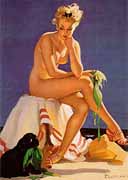
|
Starting in the late 30's, Elvgren began doing girl-next-door calendar pin-ups first for Louis F. Dow, and then for Brown and Bigelow. Elvgren and most of the artists who started out in Sundblom's studio worked in oil using a lush smooth style sometimes called the "Mayonnaise school", that gave his models a rich glowing skin.
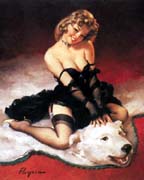
|
Coming back around to the theme we started this page off with, the picture to the right is Elvgren's "Bareback Rider", also known as "Bare Facts". In this version of the time-honored theme, Elvgren has made the bear less fierce and given him something of sly grin, his eyes cast slightly upward and to the side. Still, as with Kirchner some 40 years before, the girl is coy, innocent and tempting, and the bear stands in for the viewer.
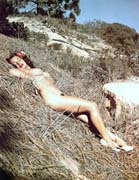
|
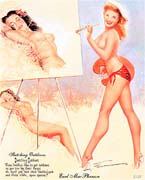
|
MacPherson was not only a painter, but like Moran and Evlgren, a skilled photographer and often worked from reference photos that he took of his models. A few of his photos have been published. The pictures to the left show his reference photo as well as the painting (and painting within a painting) that he created from it.
Photographic cheesecake had existed since the very beginning, but it wasn't until the 40's and 50's that it came into its own. The next chapter picks up the story with two photographs that have become iconic.
Brons
All Rights Reserved.The pictures used to illustrate the styles and artists reviewed here are all copyrighted by their respective creators (or their estates) or publishers and are used without explicit permission. I've done what I can to keep that use within the definitions of fair use.